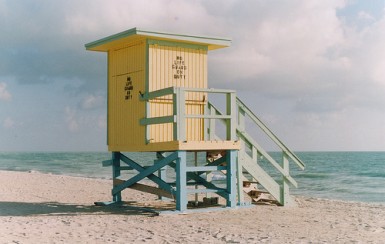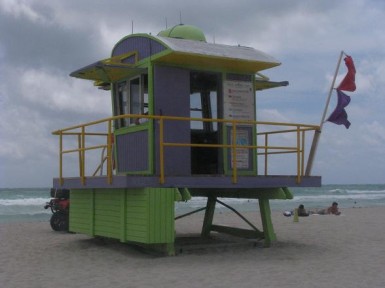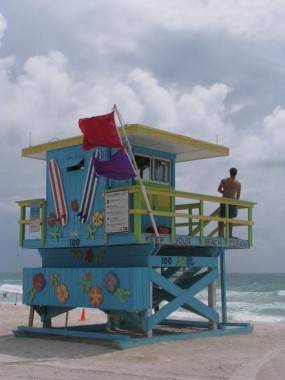The Psychedelic Lifeguard Stands on South Beach
Photo by Carlos Miller This week, I thought I’d take my eyes off what was lying on the beach, and focus them instead on what was standing on the beach, namely the colorful, psychedelic lifeguard stands that line our stretch of the Atlantic coast from South Pointe Park north to 85th Street. Take a picture of the Beach, and people will automatically know where you are: the stands have served as examples to design and architecture schools the world over of how functional architecture can also be fun and help give a city a distinctive identity. Of the 29 stands, 16 occupy the South Beach portion of the sand. Their eclectic designs range from 60’s funky to downright clunky, and in addition to their role as housing for Miami Beach Ocean Rescue, they’ve served as (unofficial) nighttime shelters for the homeless, as well as moonlit nooks for exhibitionistic lovers to consummate their lust. HOW THEY CAME TO BE
Hurricane Andrew all but leveled the former stands when it passed through in 1992, and the city of Miami Beach desperately needed some replacements. Even as the Art Deco district was blossoming anew under the renovations led by Barbara Capitman, the city also felt the need to bring a little artistic flair to the beach itself, and so began a project that would redefine beach rescue architecture as we know it. Artists were called in, including the notable Brooklyn-based painter Kenny Scharf, and the Property Management Department set up shop on the then-abandoned basketball courts of Flamingo Park. Scharf, a star player in the East Village art scene of the 1980’s, was well-known for his pop-culture inspired motifs, creations with scientific themes and imagery appropriated from 60s cartoons such as The Jetsons and The Flintsones. “Porkchop”, a poster on the Critical Miami website, reminisced about his involvement as a carpenter on the construction of three of the stands, namely “The Jetsons”, “The Duck”, and “The Wave”:
Unfortunately, today, several of the original stands have been retired to a parking lot behind the Miami Beach Convention Center. Follow the walkway along the south side of the Dade Blvd canal, and you’ll see the fenced-off enclosure where they wait in limbo for their trip to the scrap yard. Regrettably, many of the most imaginative among them have been swapped for boxy monstrosities; however, the most famous ones, such as the 10th and 12th Street stands, have been replaced with designs closely paralleling those of their predecessors. I recently spent a rather balmy afternoon trekking up the beach to document the current offerings. Here are a few of the “stand”-outs: BEST IMPERSONATION OF A LIGHTHOUSE: THE JETTY STAND
This is one example of a structure that has defied the trend toward blandness. The original, shown in this 2003 photo below, was a tiny shack barely big enough to house the lifeguard. The new over-the-top creation complements the newly revamped South Pointe Park, evoking the glory days of South Beach’s artistic revival.
(above) THE FORMER JETTY STAND, CIRCA 2003 MOST EXTRATERRESTRIAL: THE 10th STREET STAND One of the Scharf creations, this round edifice typifies his cartoonish science fiction sensibility. The pink and yellow colors are also hallmarks of Scharf’s irreverent style. Forget Pamela Anderson and David Hasselhoff! This shack looks more like the hang-out for Marvin the Martian! MOST FESTIVE: THE 12th STREET STAND All these greens and purples and yellows make this 50’s appliance-shaped concoction look somewhat like a Mardi Gras float—only this time when you’re crying “Throw me something mister”, you’ll have your hand outstretched for a life preserver. MOST PATRIOTIC: THE 13th STREET STAND You’d do Bill O’Reilly proud hanging out beside this creation. Whatever subtlety is accomplished with the nondescript boxy design is lost in the flamboyant fourth of July decor. MOST HIPPIFIED: THE 16th STREET STAND Flower power never felt more powerful than with this floral design, which looks more like it belongs on the side of an old Cheech and Chong bus than on a lifeguard stand. If you detect any strange herbal smells emanating from the windows, you might want to opt for the patriotic stand instead. HONORABLE MENTION To see the complete set of South Beach lifeguard stations, click here. While not quite as flashy as the examples above, they do have a certain sense of personality about them, much moreso than the ones in cities like Jacksonville and Daytona Beach. WHAT DO THOSE FLAGS MEAN? No, the lifeguards aren’t just being festive. The colors tell beachgoers about the surf conditions. Green means the conditions are safe; yellow signifies a moderate danger, and red warns you that there are strong, dangerous currents and/or high surf. Purple means dangerous marine life. Most of the time, when the purple flags are out, it means jellyfish are in the water. There is also another flag with a “man of war” jellyfish emblem on it, as they’re particularly annoying. Sharks, however, aren’t a major problem in the waters off Miami Beach. In fact, the last fatal shark attack in Miami-Dade County was in 1961! DO YOU WANT TO BE A LIFEGUARD? Think you’ve got what it takes to keep the waters safe? You can apply as a Miami-Dade lifeguard here (click on “Lifeguard 1”). These are the job requirements and pay for the position of “lifeguard 1”: Salary: minimum of $15.44 per hour; maximum of $20.74 per hour. Nature of Work: General lifesaving work in the preservation of safety and order at an assigned station on a public beach. ILLUSTRATIVE EXAMPLES OF ESSENTIAL DUTIES
KNOWLEDGE, SKILLS AND ABILITIES
MINIMUM REQUIREMENTS
PHYSICAL REQUIREMENTS
In addition to Miami Beach, there are also positions available at Bal Harbour, Bill Baggs Cape Florida State Park, Biscayne Park, Crandon Park, Haulover Beach, Hobie Beach, Homestead Bayfront Park, Matheson Hammock County Park, and Virginia Key Beach.
You Deserve More Than an Ordinary Vacation.
Travel with Miami Beach 411 Today!
The Miami Beach 411 Travel Store is Open 24/7.
10 Comments on"The Psychedelic Lifeguard Stands on South Beach"
|

Like what you see? Let's talk about how
we can help your vacation --> Contact Us |
|
Like what you see? Let's talk about
how we can help your vacation
--> Contact Us
how we can help your vacation
--> Contact Us





























Maria de los Angeles says:
Great article and overview, Doug! These stands are indeed iconic.
Posted on 06/08/2009 at 11:35 AM